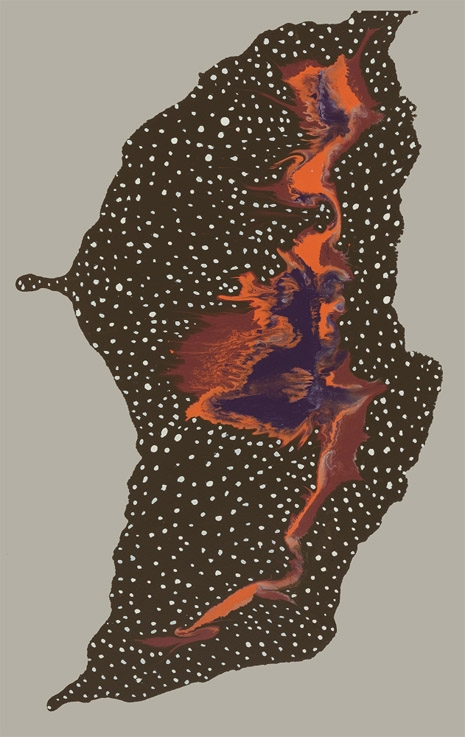Occult paintings and mystical visions of female surrealist Ithell Colquhoun

Like the Abstract Expressionist movement that followed in its wake, Surrealism's history has largely been written as a narrative of heroic transgressions committed by
bad boys, which did no favors for the women involved in the movement. Even Surrealism's most celebrated woman artists—Meret Oppenheim, whose "Breakfast in Fur" was the first
objet acquired by MoMA, and Lee Miller, who moved on from Surrealism to become a celebrated photojournalist—are arguably as well or even better known as nude models for photos by Man Ray as for their own achievements.
Not only was
that at work in ensuring that painter/poet
Ithell Colquhoun remained an obscure figure, there's her strong supernatural bent. Surrealism's interest in automatism in writing and drawing was held in service of suppressing the discipline of the conscious mind in order to develop the unconscious, triggering creativity-enhancing states. But Colquhoun used Surrealism's methods in service of Hermeticism. She sought not merely the unconscious, but the
mystical and transcendent. This pursuit led to her ouster from the official English Surrealist group in 1940. She continued to paint, eschewing her early representational style in favor of increasing automatism, and she increased her involvement in the occult, participating in the Ordo Templi Orientis, and the Golden Dawn splinter group Stella Matutina.
Colquhoun's biography and body of work merit far deeper exploration than I can offer here, and I'd strongly encourage anyone interested in Surrealism or esoteric art who don't already know her to engage in that deep dive. The video at the very end of this post isn't a terrible place to start. What concerns us today is a suite of her paintings and connected esoteric poetic writings called
Decad of Intelligence. Based on an early Kabbalistic treatise known as the
Sefer Yetzirah, the ten painting/writing pairs were created in 1978 and 1979, based on ten "Sephiroth," aspects of infinity revealed in creation. The
Decad has been published in full for the first time as an extraordinary set of prints and an accompanying book by Fulgur Limited, a UK publisher concerned with the intersections between the esoteric and visual art (if you're familiar with
Abraxas Journal, you know Fulgur). From Dr Amy Hale's introduction:
A key to understanding the way in which the Decad was designed to work may be found in Colquhoun's relationship to colour theory, in which she was interested from early in her formal arts training. In the 1930s she studied at the London atelier of Amédée Ozenfant, who spearheaded scientific colour theory in Britain, particularly concentrated on the effects of colour in architecture. Colquhoun's own studies of colour theory were underpinned by her interest in the Golden Dawn magical system and reinforced for her the idea that colours hold the power to communicate both concrete and more ineffable spiritual principles. Similarly to the theories put forward by Kandinsky in his 1911 text Concerning the Spiritual in Art, Colquhoun believed that colours were themselves intelligences and gateways to other planes of existence.
The Decad of Intelligence…was designed to be a small book of ten enamel pieces, each depicting a different sephira, accompanied by a description of their properties. The enamel is thickly laid on the paper, and each piece is a colour study, encompassing the colours of each of the four colour scales of the Tree of Life. Her text is extremely regular in construction, and provides a list of of the correspondences of each sephira, including its location, corresponding part of the body, elemental and planetary associations, fragrances and flowers, alchemical associations, and the vision that the sephira is intended to inspire.
The prints in the folio are quite vivid, printed with metallic highlights that help to capture the essence of the enamel originals. The versions of the same works in the booklet are still quite nice, but less expensively printed, and the digital images we have to share with you resemble the latter more closely. They give you the idea quite well enough. Elements of the corresponding poems were derived from information found in Aleister Crowley's
Liber 777, and perhaps accordingly, the
Decad of Intelligence is limited to 777 copies.

ABSOLUTE OR PERFECT INTELLIGENCE
Sphere of Mercury
Pillar of Water
Splendour a Hermaphrodite
Opal storax moly
Quicksilver mescal
Left foot navel
The names versicles and apron octagram
Zinc Venus as metal
Jackal of the west healer of plagues
Truthfulness angelic Sons of God
Analysis into Four Elements vision of splendour

INTELLIGENCE OF THE MEDIATING INFLUENCE
Sphere of Sol
Pillar of Air
Beauty the Princes a child as majestic king
Topaz yellow diamond oliban
Acacia bay laurel vine
Stramonium alcohol digitalis coffee
Trunk heart
Lamen calvary-cross truncated pyramid cube
Iron Mars as metal
Child phoenix and lion of the depths
Divine bringer of sunshine
Devotion to the Great Work angelic Kings
The enlightened one vision of the harmony of things

RESPLENDENT INTELLIGENCE
Sphere of the Elements
Root of elemental earth
Kingdom the Princess a young woman crowned
and veiled
Rock crystal dittany of Crete
Willow lily ivy
Magnesium-sulphate corn
Anus foreskin
The magical circle and triangle
Altar of the double cube
Philosophical mercury medicine of metals
Sphinx of the north
Blessed Virgin
Scepticism angelic Flames
The body vision of the Holy Guardian Angel
Previously on Dangerous Minds:
‘Witchcraft and Black Magic’: Surreal occult fantasy paintings
‘The Love Witch’: Sex magick meets pussy power in occult movie mindbender
New witchcraft museum features occult artifacts once owned by Aleister Crowley



